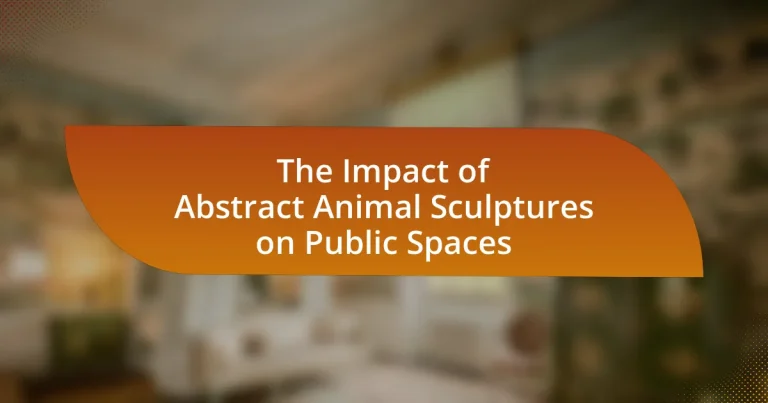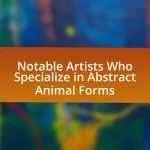Abstract animal sculptures are artistic representations that prioritize form, color, and texture over realistic depictions of animals, allowing for personal interpretation by viewers. This article explores their significance in public art, highlighting how they enhance community identity, foster engagement, and contribute to the aesthetic value of urban spaces. It examines the characteristics that distinguish these sculptures from traditional art forms, the influence of cultural interpretations on their design, and their psychological effects on viewers. Additionally, the article discusses the challenges of maintaining these sculptures and best practices for their implementation in public environments, emphasizing their role in urban design and planning.
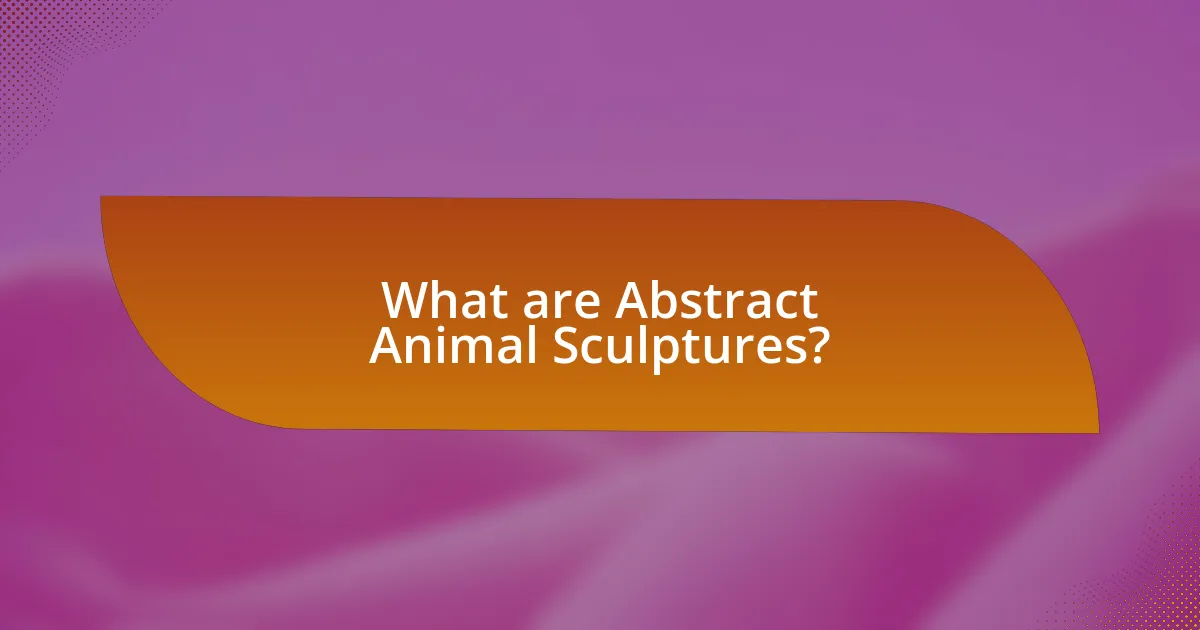
What are Abstract Animal Sculptures?
Abstract animal sculptures are artistic representations of animals that emphasize form, color, and texture rather than realistic depiction. These sculptures often utilize geometric shapes and stylized features to convey the essence or spirit of the animal, allowing for personal interpretation by the viewer. The use of abstraction in animal sculptures can be traced back to various art movements, including modernism, where artists sought to break away from traditional representations. This approach not only enhances aesthetic appeal but also encourages engagement and dialogue within public spaces, making them significant in contemporary art installations.
How are Abstract Animal Sculptures defined in the context of public art?
Abstract animal sculptures in the context of public art are defined as artistic representations that use non-representational forms to convey the essence or characteristics of animals. These sculptures often prioritize shape, color, and texture over realistic depiction, allowing for a broader interpretation by the viewer. For instance, the work of artists like Henry Moore and Barbara Hepworth exemplifies how abstract forms can evoke the spirit of animals while engaging the public in a dialogue about nature and creativity. Public installations of such sculptures contribute to the aesthetic and cultural landscape of urban environments, enhancing community spaces and encouraging interaction among diverse audiences.
What characteristics distinguish Abstract Animal Sculptures from other art forms?
Abstract Animal Sculptures are distinguished from other art forms by their emphasis on stylization, abstraction, and the evocation of emotion rather than realistic representation. Unlike traditional sculptures that aim to replicate the physical characteristics of animals, abstract animal sculptures often utilize geometric shapes, unconventional materials, and vibrant colors to convey a sense of movement and energy. This approach allows artists to explore themes of nature, identity, and the human-animal relationship in a more conceptual manner. For instance, the works of artists like Henry Moore and Barbara Hepworth exemplify how abstraction can transform the perception of animal forms, inviting viewers to engage with the artwork on a deeper emotional level rather than merely appreciating its physical likeness.
How do cultural interpretations influence the design of Abstract Animal Sculptures?
Cultural interpretations significantly influence the design of Abstract Animal Sculptures by shaping the symbolism and aesthetics associated with the represented animals. For instance, in many Indigenous cultures, animals are often viewed as spiritual beings, which leads artists to incorporate elements that reflect these beliefs, such as using specific colors or forms that resonate with cultural narratives. Additionally, in Western contexts, abstract representations may focus on stylization and minimalism, reflecting contemporary artistic trends and societal values. This divergence in design approaches illustrates how cultural backgrounds dictate not only the visual aspects but also the intended messages of the sculptures, reinforcing the connection between art and cultural identity.
Why are Abstract Animal Sculptures significant in public spaces?
Abstract animal sculptures are significant in public spaces because they enhance aesthetic appeal and foster community engagement. These sculptures often serve as focal points that attract visitors, encouraging social interaction and cultural exchange. For instance, a study by the National Endowment for the Arts found that public art installations, including abstract sculptures, can increase foot traffic in urban areas by up to 30%, demonstrating their role in revitalizing public spaces. Additionally, abstract animal sculptures can symbolize local identity and values, creating a sense of belonging among residents.
What role do Abstract Animal Sculptures play in enhancing community identity?
Abstract animal sculptures play a significant role in enhancing community identity by serving as unique symbols that reflect local culture and values. These sculptures often incorporate elements specific to the community’s history, wildlife, or artistic traditions, fostering a sense of belonging among residents. For instance, a study by the National Endowment for the Arts found that public art, including abstract sculptures, can increase community engagement and pride, as they become focal points for social interaction and local events. By visually representing the community’s character, abstract animal sculptures contribute to a shared identity and promote a cohesive community narrative.
How do these sculptures contribute to the aesthetic value of public spaces?
Abstract animal sculptures enhance the aesthetic value of public spaces by introducing unique artistic expressions that engage viewers and stimulate emotional responses. These sculptures often serve as focal points, drawing attention and encouraging social interaction among visitors. For instance, studies have shown that public art installations, including abstract sculptures, can increase foot traffic and community engagement, as seen in cities like Chicago, where public art initiatives have led to a 20% increase in local business revenue. Additionally, the incorporation of abstract forms can create a dialogue between nature and urban environments, enriching the visual landscape and promoting a sense of place.
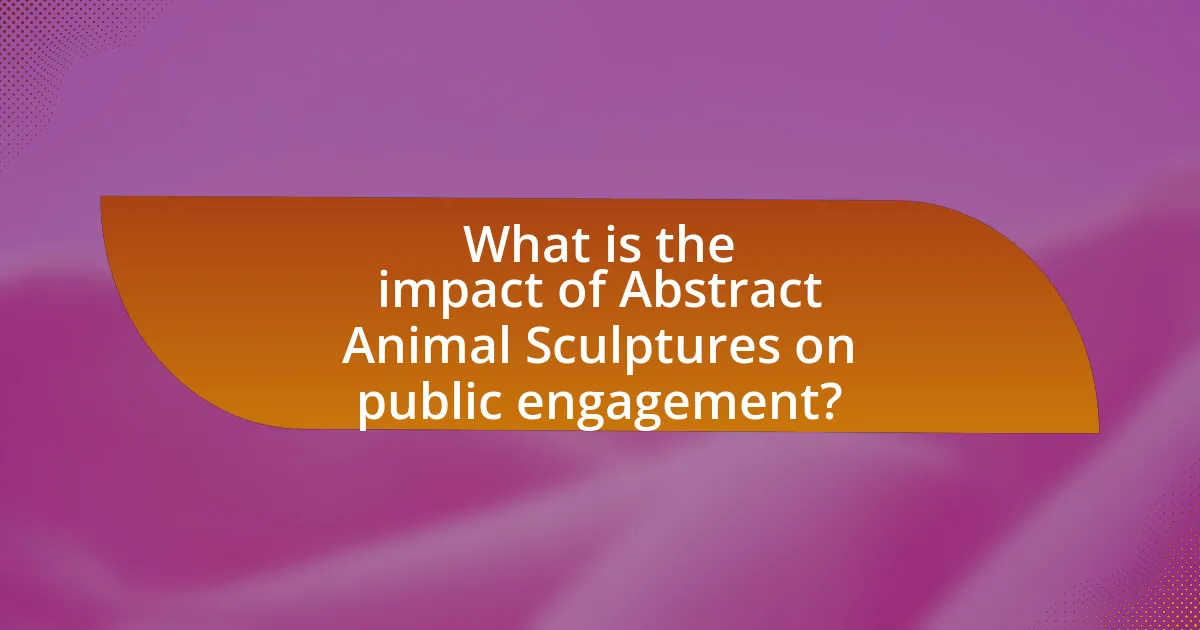
What is the impact of Abstract Animal Sculptures on public engagement?
Abstract animal sculptures significantly enhance public engagement by serving as focal points that stimulate conversation and interaction among viewers. These sculptures often evoke emotional responses and encourage people to explore their interpretations, fostering a sense of community and shared experience. Research indicates that public art, including abstract animal sculptures, can increase foot traffic in public spaces by up to 30%, as seen in various urban studies. Additionally, such artworks can promote cultural identity and pride, as they often reflect local values and narratives, further deepening public involvement and appreciation for the arts.
How do Abstract Animal Sculptures encourage interaction among the public?
Abstract animal sculptures encourage interaction among the public by serving as engaging focal points that invite exploration and conversation. These sculptures often feature unique shapes and vibrant colors, which attract attention and stimulate curiosity. For instance, studies have shown that public art installations, including abstract sculptures, can increase foot traffic in urban areas by up to 30%, as people are drawn to interact with the art and each other. This interaction fosters a sense of community and encourages social engagement, as individuals gather around the sculptures to take photos, discuss their interpretations, or simply enjoy the shared experience.
What types of interactions do these sculptures promote?
Abstract animal sculptures promote social interactions, emotional engagement, and aesthetic appreciation among viewers. These sculptures often serve as focal points in public spaces, encouraging people to gather, converse, and share experiences. Research indicates that public art, including abstract sculptures, enhances community connectivity and fosters a sense of belonging, as evidenced by studies showing increased foot traffic and socialization in areas featuring such installations.
How can Abstract Animal Sculptures serve as conversation starters in communities?
Abstract animal sculptures can serve as conversation starters in communities by provoking curiosity and encouraging dialogue among viewers. These sculptures often feature unique designs that challenge traditional representations of animals, prompting individuals to interpret their meanings and share personal perspectives. For instance, a study by the University of California found that public art installations, including abstract sculptures, significantly increase social interactions among community members, fostering a sense of belonging and engagement. This interaction is further enhanced when sculptures are placed in communal areas, where people naturally gather, leading to discussions about art, nature, and cultural significance.
What psychological effects do Abstract Animal Sculptures have on viewers?
Abstract animal sculptures evoke a range of psychological effects on viewers, including emotional engagement, contemplation, and a sense of connection to nature. These sculptures often stimulate curiosity and provoke thought, leading individuals to interpret the artwork in personal ways, which can enhance their emotional experience. Research indicates that exposure to art, including abstract forms, can reduce stress and promote well-being by encouraging mindfulness and reflection. For instance, a study published in the Journal of Environmental Psychology found that interacting with art in public spaces can lead to increased feelings of happiness and community belonging. Thus, abstract animal sculptures not only serve as aesthetic objects but also play a significant role in influencing the psychological state of viewers.
How do these sculptures influence emotional responses in public spaces?
Abstract animal sculptures influence emotional responses in public spaces by evoking feelings of curiosity, joy, and contemplation among viewers. These sculptures often utilize vibrant colors and dynamic forms that capture attention and stimulate engagement, leading to positive emotional reactions. Research indicates that art in public spaces can enhance community well-being and social interaction, as seen in studies like “The Role of Public Art in Urban Spaces” by the National Endowment for the Arts, which highlights how public art fosters emotional connections and enhances the aesthetic experience of urban environments.
What studies support the psychological benefits of viewing Abstract Animal Sculptures?
Studies indicate that viewing abstract animal sculptures can enhance psychological well-being by reducing stress and promoting positive emotions. For instance, research published in the journal “Environment and Behavior” by authors Kaplan and Kaplan (1989) demonstrates that exposure to art in public spaces, including abstract sculptures, can lead to increased feelings of relaxation and happiness. Additionally, a study by Ulrich (1991) in “Health and Place” found that engaging with artistic representations, such as abstract animal forms, can significantly lower anxiety levels and improve mood. These findings collectively support the notion that abstract animal sculptures contribute positively to mental health in public environments.
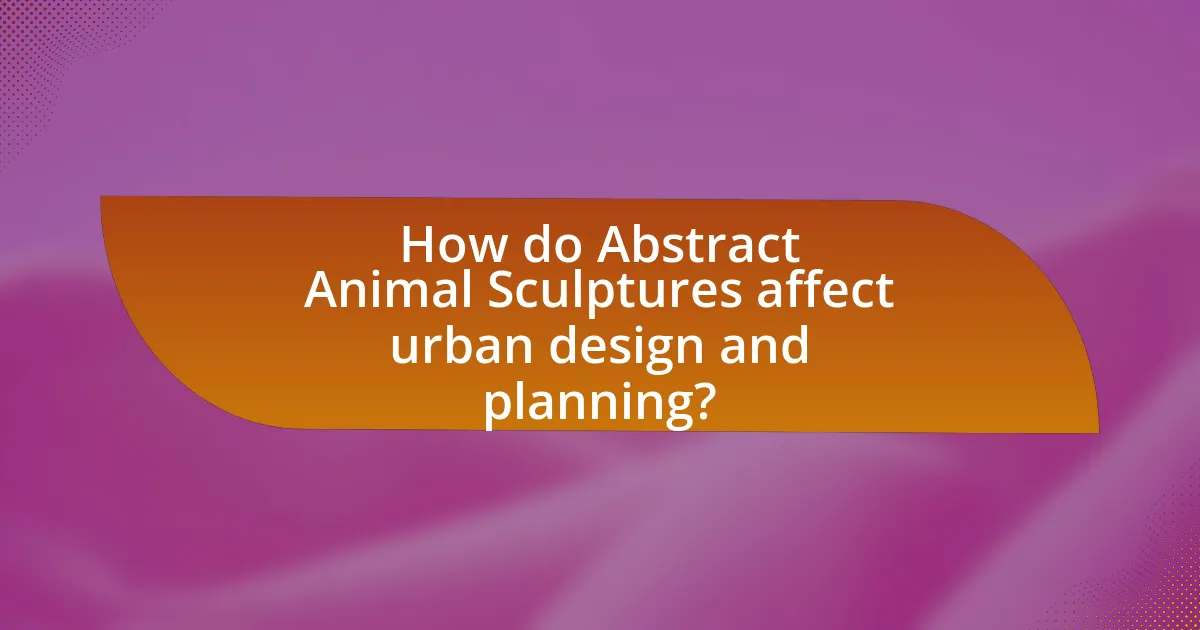
How do Abstract Animal Sculptures affect urban design and planning?
Abstract animal sculptures significantly influence urban design and planning by enhancing aesthetic appeal and fostering community engagement. These sculptures serve as focal points in public spaces, attracting visitors and encouraging social interaction, which can lead to increased foot traffic and economic activity in the area. Research indicates that public art, including abstract sculptures, contributes to a sense of place and identity, making urban environments more vibrant and inviting. For instance, a study by the National Endowment for the Arts found that cities with prominent public art installations experience higher levels of community pride and involvement. Thus, the integration of abstract animal sculptures into urban planning not only beautifies the environment but also promotes social cohesion and economic vitality.
What considerations are taken into account when integrating Abstract Animal Sculptures into urban environments?
When integrating Abstract Animal Sculptures into urban environments, key considerations include aesthetic appeal, cultural relevance, spatial context, and community engagement. Aesthetic appeal ensures that the sculptures enhance the visual landscape, while cultural relevance connects the artwork to local traditions or narratives, fostering a sense of identity. Spatial context involves assessing the location’s architecture, natural surroundings, and pedestrian flow to ensure the sculptures are appropriately placed and accessible. Community engagement is crucial, as involving local residents in the design process can lead to greater acceptance and appreciation of the artwork. These considerations are supported by studies indicating that well-integrated public art can improve community cohesion and enhance the overall urban experience.
How do these sculptures impact pedestrian flow and public safety?
Abstract animal sculptures can significantly influence pedestrian flow and public safety by altering movement patterns and creating focal points in public spaces. These sculptures often attract attention, which can lead to increased foot traffic in their vicinity, potentially causing congestion. For instance, a study by the University of California found that installations of large public art pieces can increase pedestrian activity by up to 30%. Additionally, the presence of sculptures can enhance safety by encouraging social interaction and surveillance, as more people in an area can deter criminal activity. Research published in the Journal of Urban Design indicates that well-placed public art contributes to a sense of community, which is linked to lower crime rates. Thus, while abstract animal sculptures can enhance aesthetic appeal, they also play a crucial role in shaping pedestrian dynamics and promoting safety in urban environments.
What are the challenges of maintaining Abstract Animal Sculptures in public spaces?
The challenges of maintaining Abstract Animal Sculptures in public spaces include exposure to environmental elements, vandalism, and the need for regular cleaning and restoration. Environmental factors such as weather, pollution, and UV radiation can cause deterioration of materials like metal, stone, or resin, leading to structural damage or fading. Vandalism poses a significant risk, as sculptures may be subject to graffiti or physical damage, necessitating repairs or protective measures. Additionally, regular maintenance is required to ensure the sculptures remain visually appealing and safe for public interaction, which can strain municipal budgets and resources. These challenges highlight the complexities involved in preserving artistic installations in outdoor settings.
What are the best practices for implementing Abstract Animal Sculptures in public spaces?
The best practices for implementing Abstract Animal Sculptures in public spaces include ensuring community engagement, selecting appropriate locations, and considering maintenance needs. Community engagement fosters local support and input, which can enhance the sculpture’s relevance and acceptance. Selecting locations that attract foot traffic and complement the surrounding environment maximizes visibility and interaction. Additionally, planning for maintenance ensures the sculptures remain in good condition, which is crucial for long-term public enjoyment and aesthetic appeal. Research indicates that well-maintained public art can increase community pride and enhance the overall atmosphere of public spaces.
How can communities effectively select and commission Abstract Animal Sculptures?
Communities can effectively select and commission Abstract Animal Sculptures by establishing a clear selection process that involves public input, collaboration with artists, and adherence to budget constraints. Engaging community members through surveys or public meetings ensures diverse perspectives are considered, fostering a sense of ownership and relevance in the artwork. Collaborating with local artists or art organizations can enhance the quality and cultural significance of the sculptures, as they bring expertise and a connection to the community’s identity. Additionally, setting a defined budget helps streamline the commissioning process, ensuring that financial resources are allocated efficiently. This approach is supported by successful case studies, such as the “Public Art Program” in San Francisco, which emphasizes community involvement and artist collaboration, resulting in impactful public art that resonates with residents.
What strategies can be employed to ensure the longevity and relevance of these sculptures?
To ensure the longevity and relevance of abstract animal sculptures in public spaces, regular maintenance and community engagement are essential strategies. Regular maintenance, including cleaning, restoration, and protective measures against environmental damage, helps preserve the physical integrity of the sculptures. For instance, sculptures made from materials like bronze or stone require periodic inspections to address wear and tear, which can extend their lifespan significantly.
Community engagement fosters a connection between the sculptures and the public, enhancing their relevance. Organizing educational programs, workshops, or interactive events around the sculptures can promote appreciation and understanding of the art, ensuring that they remain a vital part of the community’s cultural landscape. Research indicates that public art initiatives that involve local communities tend to have higher levels of public support and interaction, which can lead to sustained interest and care for the artworks.
By combining these strategies, abstract animal sculptures can maintain their aesthetic and cultural significance over time.
